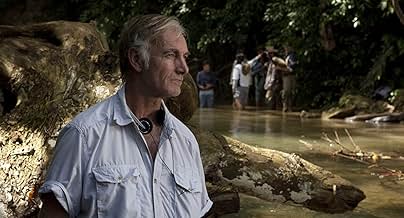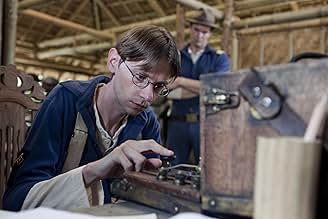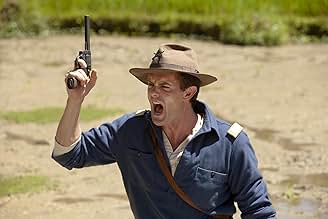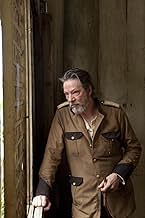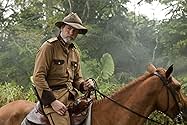Aggiungi una trama nella tua linguaA fictional account of events during the Philippine-American War.A fictional account of events during the Philippine-American War.A fictional account of events during the Philippine-American War.
- Regia
- Sceneggiatura
- Star
- Premi
- 1 vittoria e 9 candidature totali
Hoffman Cheng
- Chop-Chop
- (as Sai Ho Cheng)
Reymart Colestines
- Malpulgas
- (as Raymart Colestines)
Miguel Faustmann
- Captan Narvaez
- (as Miguel Faustman)
Trama
Lo sapevi?
- QuizBefore Amigo, the last movie about American forces in the Philippines was John Dahl-directed The Great Raid - Un pugno di eroi (2005) which tackled World War II in the Philippines. Also in that movie was Bembol Roco who also appears in Amigo. Also in The Great Raid - Un pugno di eroi (2005) was Cesar Montano who, just like Joel Torre, also plays Jose Rizal in José Rizal (1998).
- ConnessioniFeatured in Bottomline: John Sayles (2011)
- Colonne sonoreKundiman of 1896 (Jocelynang Baliwag)
Traditional
Arranged and performed by Raul Manikan
Daring Music/Administered by Universal Music Corp./ASCAP
Recensione in evidenza
It is always difficult to tackle a war on film equally and fairly. Each side has its own interests to protect and uphold. Everyone regards the other as an enemy against them. There will be losses from all sides, direct and collateral. Yet, in the end, no one really wins. In "Amigo" by veteran director John Sayles, attempts to show all sides of a multi- dimensional conflict that was the Philippine-American War.
The film brings us back to the turn of the previous century, 1900, when Spain just ceded the Philippines to the USA. A group of young American soldiers under former architect Lt. Compton (Garrett Dillahunt) take control of a remote village called San Isidro. Trying to maintain some semblance of normalcy in his hostaged neighborhood was the barrio captain Rafael Dacanay (Joel Torre). There was also the Spanish friar Padre Hidalgo who continues his churchly mission, while interpreting for the Americans. On the other front, we have the Filipino revolutionaries who camp out in the jungle, led by Rafael's brother Simon (Ronnie Lazaro).
So we can see here a complicated web of intersecting conflicts that Sayles weaved for us. This was presented in a way that the audience can see the way each of these groups thought. The dialog went from English to Tagalog to Spanish and the occasional Chinese, so everything was seemingly told "in their own words." It will be very interesting how this movie will be viewed by audiences represented by the involved parties. While the story had a slow progression at the start, by the time it reached the climactic scenes, the suspense and tension was electric. The ending though was a bit awkward in my opinion. But definitely, the audience, especially the Filipinos, will identify with the conflicts within the tragic character of Rafael, who was caught between keeping the peace in his barrio, and his brother's cause for Filipino independence.
Joel Torre properly captures Rafael's essence and plays him with fervor and passion. Of course, with all the rather hammy acting of the unknown foreign actors behind them, the talent of Torre and the rest of the veteran Filipino cast (notably Rio Locsin as Rafael's religious wife) shone right through. The one known American actor Chris Cooper was in a one-dimensional villain role as a war freak American colonel. As the friar, Yul Vasquez seemed to be more American than Spanish, as he even had a forced Spanish accent. But I do congratulate him for his very good Tagalog speaking. I'm not very sure if it is an error, but I noted the Chinese characters (who were apparently there for comic relief) were speaking in Cantonese, but the predominant Chinese dialect in the Philippines should be Fukienese.
Overall though, this is a very good and thoughtful film about a war that had not been tackled before in Hollywood before. To his credit, American John Sayles directed this movie as if he was a true Filipino. He was successful in telling us his story from the Filipino point of view. He was even able to inject some vignettes of Filipino rural culture with scenes of a fiesta, a funeral and cockfighting. Filipinos should really go out and support this unique motion picture.
The film brings us back to the turn of the previous century, 1900, when Spain just ceded the Philippines to the USA. A group of young American soldiers under former architect Lt. Compton (Garrett Dillahunt) take control of a remote village called San Isidro. Trying to maintain some semblance of normalcy in his hostaged neighborhood was the barrio captain Rafael Dacanay (Joel Torre). There was also the Spanish friar Padre Hidalgo who continues his churchly mission, while interpreting for the Americans. On the other front, we have the Filipino revolutionaries who camp out in the jungle, led by Rafael's brother Simon (Ronnie Lazaro).
So we can see here a complicated web of intersecting conflicts that Sayles weaved for us. This was presented in a way that the audience can see the way each of these groups thought. The dialog went from English to Tagalog to Spanish and the occasional Chinese, so everything was seemingly told "in their own words." It will be very interesting how this movie will be viewed by audiences represented by the involved parties. While the story had a slow progression at the start, by the time it reached the climactic scenes, the suspense and tension was electric. The ending though was a bit awkward in my opinion. But definitely, the audience, especially the Filipinos, will identify with the conflicts within the tragic character of Rafael, who was caught between keeping the peace in his barrio, and his brother's cause for Filipino independence.
Joel Torre properly captures Rafael's essence and plays him with fervor and passion. Of course, with all the rather hammy acting of the unknown foreign actors behind them, the talent of Torre and the rest of the veteran Filipino cast (notably Rio Locsin as Rafael's religious wife) shone right through. The one known American actor Chris Cooper was in a one-dimensional villain role as a war freak American colonel. As the friar, Yul Vasquez seemed to be more American than Spanish, as he even had a forced Spanish accent. But I do congratulate him for his very good Tagalog speaking. I'm not very sure if it is an error, but I noted the Chinese characters (who were apparently there for comic relief) were speaking in Cantonese, but the predominant Chinese dialect in the Philippines should be Fukienese.
Overall though, this is a very good and thoughtful film about a war that had not been tackled before in Hollywood before. To his credit, American John Sayles directed this movie as if he was a true Filipino. He was successful in telling us his story from the Filipino point of view. He was even able to inject some vignettes of Filipino rural culture with scenes of a fiesta, a funeral and cockfighting. Filipinos should really go out and support this unique motion picture.
I più visti
Accedi per valutare e creare un elenco di titoli salvati per ottenere consigli personalizzati
- How long is Amigo?Powered by Alexa
Dettagli
- Data di uscita
- Paesi di origine
- Siti ufficiali
- Lingue
- Celebre anche come
- Baryo
- Luoghi delle riprese
- Aziende produttrici
- Vedi altri crediti dell’azienda su IMDbPro
Botteghino
- Budget
- 1.500.000 USD (previsto)
- Lordo Stati Uniti e Canada
- 184.705 USD
- Fine settimana di apertura Stati Uniti e Canada
- 37.324 USD
- 21 ago 2011
- Lordo in tutto il mondo
- 184.705 USD
- Tempo di esecuzione2 ore 4 minuti
- Colore
Contribuisci a questa pagina
Suggerisci una modifica o aggiungi i contenuti mancanti



